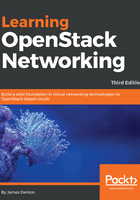
Overlay networks
Neutron supports overlay networking technologies that provide network isolation at scale with little to no modification of the underlying physical infrastructure. To accomplish this, Neutron leverages L2-in-L3 overlay networking technologies such as GRE, VXLAN, and GENEVE. When configured accordingly, Neutron builds point-to-point tunnels between all network and compute nodes in the cloud using a predefined interface. These point-to-point tunnels create what is called a mesh network, where every host is connected to every other host. A cloud consisting of one combined controller and network node, and three compute nodes, would have a fully meshed overlay network that resembles figure 1.2:

Using the overlay network pictured in figure 1.2, traffic between instances or other virtual devices on any given host will travel between layer 3 endpoints on each of the underlying hosts without regard for the layer 2 network beneath them. Due to encapsulation, Neutron routers may be needed to facilitate communication between different project networks as well as networks outside of the cloud.